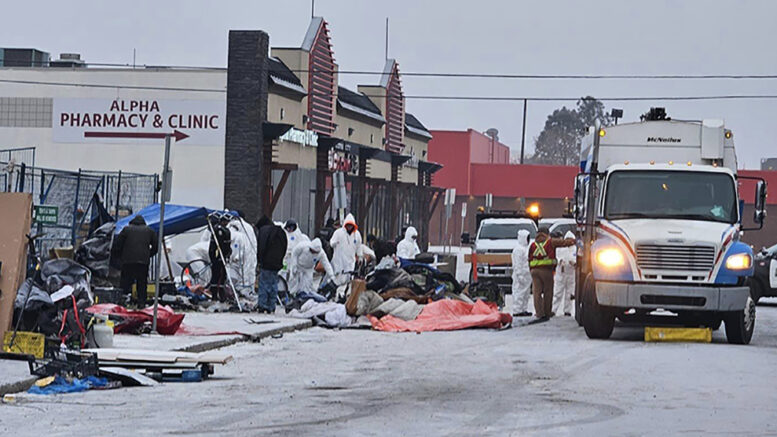By Jeremy Appel, Local Journalism Initiative Reporter
(ANNews) – Edmonton police completed their new year sweep of eight “high-risk” homeless encampments as the wind chill temperature dropped to -30 degrees Celsius on Jan. 10. They made three arrests at the final targeted encampment, including the camp elder and an independent Indigenous journalist who was covering the closures.
Online media outlet Ricochet confirmed that Brandi Morin was arrested while on assignment for them, documenting police’s “violent” arrests at the encampment at 95 Street and Rowland Road, and charged with obstruction of justice.
By the evening, Morin was released and charged with obstructing a peace officer, with her next court date scheduled for Feb. 1.
“We are dismayed and shocked that the Edmonton Police Service would arrest a working journalist,” wrote Ricochet senior editor Ethan Cox.
“Doubly so that they would threaten to charge her with a criminal offence. We demand her immediate release, and the dropping of all charges, consistent with established legal precedent in Canada regarding the rights of working journalists.”
Andrea Houston, the outlet’s managing editor, noted the appearance that Morin “was arrested while filming a series of violent arrests that police would rather the public not see.”
“Her footage is also in custody, and we are unable to report fully on today’s events without her participation,” Houston added.
Video captured by local independent news site the Progress Report shows police shoving encampment supporters while taking camp Elder Roy Cardinal, who was known affectionately by camp residents as “Big Man,” to the ground and then leading him away in handcuffs. Another video shows Morin’s arrest.
A widely circulated video from Jan. 9, as police began the process of tearing down the encampment, appeared to show a cop tasing an Indigenous man after he was pinned to the ground. The individual was later identified as Teyen Bohnsack, who is Dene and Blackfoot.
But police say the taser was only activated, not used on Bohnsack, who was arrested for assaulting a peace officer.
The Edmonton Police Service (EPS) began that day with a press conference showcasing weapons they had confiscated from an encampment in Dawson Park that was dismantled last week, alongside graphic images of people who have died in encampments while attempting to stay warm and from overdoses.
Deputy police chief Warren Dreichel said these images show that it’s “worth it” for police to close the encampments.
Premier Danielle Smith said that by sharing the images, the police provided a “sobering reminder that illegal encampments pose a significant risk to not only our most vulnerable, who are being preyed upon by organized crime, but also to the surrounding communities at large.”
The sweep was originally slated for the final week of December, but an interim order from the Court of King’s Bench required police and city officials to provide 48-hours notice to encampment residents of an impending closure, to take the weather into account and ensure that there’s adequate shelter space for those residents.
The city and province maintain there are shelter spaces available, but the Coalition for Justice and Human Rights, which is challenging the sweep in court, says these figures don’t account for “whether there is enough space for all who currently need emergency shelter.”
Chad Charland, who comes from Cold Lake First Nation, has made the 95 Street encampment his home for the past several months, where he said residents have built their own community.
“I know I can count on them, and they know they can count on me,” Charland said.
He told Alberta Native News on Jan. 9 that he’d rather live in a tent outside, using a heater and layers of blankets to stay warm, than stay in a shelter.
“It’s a lot safer [here]. I actually feel OK to sleep,” Charland explained.
He said he has “no idea” where he’ll go if he’s evicted.
Charland added that he’s never experienced hostility from anyone in the neighbourhood. “We don’t try to cause any problems around here. Everyone’s OK with us being here,” he said.
Veronica Fuentes, a local community organizer whose mother is from Yellow Quill First Nation in Saskatchewan, told Alberta Native News that the 2024 encampment sweeps are reminiscent of the dismantling of Camp Pekiwewen in November 2020.
“Every year the city acts like they’re confused that it’s snowing, and they don’t have a cold weather plan,” said Fuentes.
At least two of the encampments targeted for closure last week returned within days. “Typically, the tents will come right back up, as they have for thousands of years,” quipped Fuentes.
She noted that the issue in Edmonton, where Indigenous people represent eight per cent of the general population but 58 per cent of the unhoused population, runs far deeper than a lack of affordable housing.
More affordable housing options is important, she emphasized, but will not on its own redress hundreds of years of displacing Indigenous Peoples.
“Encampment sweeps aren’t just about housing. They have everything to do with the ongoing land displacement, erasure, and analiving of Indigenous people for the … violent settler colonial war machine of Canada,” Fuentes said.
Fuentes said she’d like to see the city create a “better damn plan for responding to this,” one which allows Indigenous people to live freely on their own territory.
The city could keep warming stations open past 8 p.m., make shelters inclusive towards people who use drugs, have pets or have a romantic partner, and provide enhanced wraparound support for people experiencing homelessness, Fuentes suggested.
“Let our people exist in our homelands the way that they deserve to,” she said.



Be the first to comment on "Edmonton police arrest Indigenous journalist as encampment sweep turns violent"